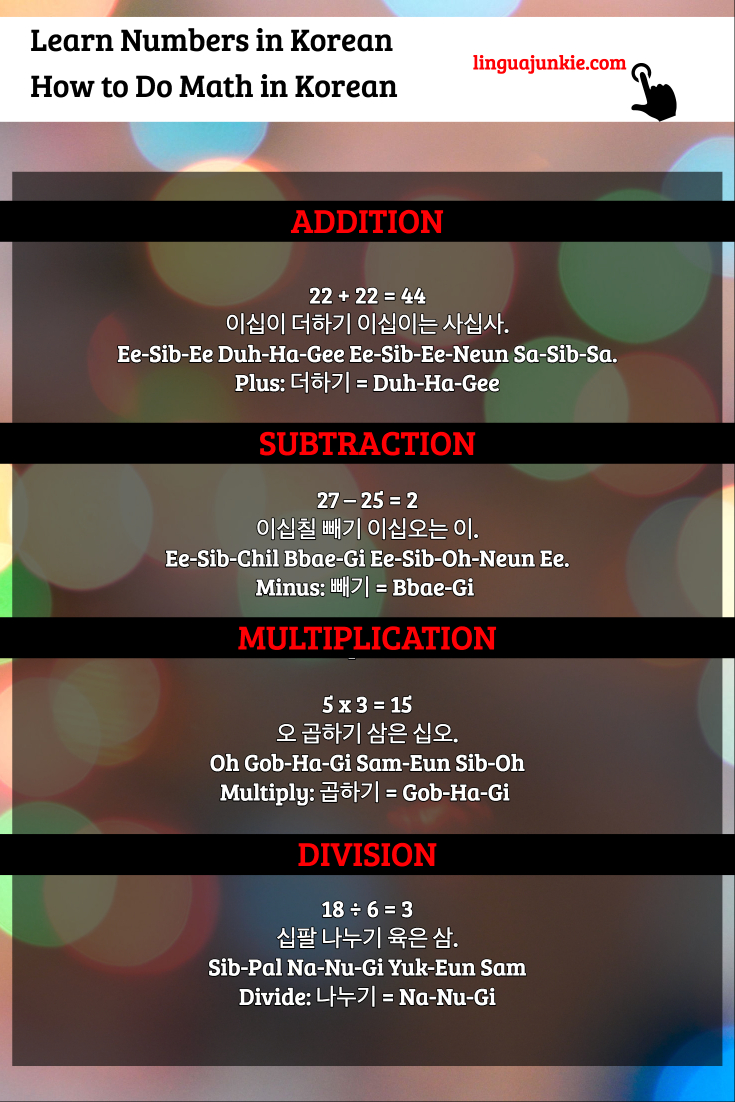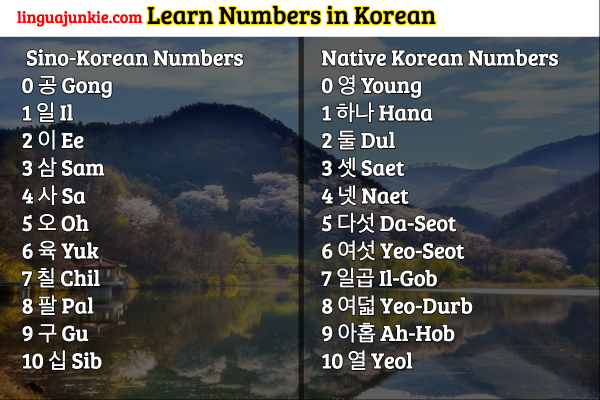Hi there!
Counting in Korean 1-100. Is it hard? No.
If you’re learning Korean with a Korean program or books and learning all those words and phrases, you will ALSO NEED numbers. Counting in Korean will help you…
- Talk about your age in Korean
- Get the phone numbers
- Get rich or die trying
So, here’s how you start counting in Korean, from 1 to 100 in 5 minutes.
- Part 1: 0 to 10 in Korean
- Part 2: 11 to 20 in Korean
- Part 3: 21 to 30
- Part 4: Counting to 100 in Korean
- Part 5: How to Do Math in Korean

Before we begin, you need to know that there are 2 ways of counting numbers in Korean. There’s 1) the Sino-Korean system and 2) the Native Korean System. What’s the difference? The Sino-Korean System is used for:
- time (minutes), units of time, the names of months, counting money, saying phone numbers, counting measurements, and etc.
The Native Korean System is used for:
- time (hours), counting objects, counting number of people, age, and for counting in general!
You need to remember to never mix or combine Sino-Korean system with Native Korean system in when describing a number. Stick to appropriate system! Hey, but don’t worry! It’s not complicated at all!
1 Counting in Korean: 0 to 10
You should also listen and hear real Korean. Press play below. Try this Free Lesson from KoreanClass101.com (click here to visit).
Here are the basics.
Just like English, once you learn 0-10, the rest is easy.
So, make sure you memorize these. Feel free to print out this page if you have to.
| # | Sino-Korean | Pronounced | Native Korean | Pronounced |
| 0 | 공 | Gong | 영 | Young |
| 1 | 일 | Il | 하나 | Hana |
| 2 | 이 | Ee | 둘 | Dul |
| 3 | 삼 | Sam | 셋 | Saet |
| 4 | 사 | Sa | 넷 | Naet |
| 5 | 오 | Oh | 다섯 | Da-Seot |
| 6 | 육 | Yuk | 여섯 | Yeo-Seot |
| 7 | 칠 | Chil | 일곱 | Il-Gob |
| 8 | 팔 | Pal | 여덟 | Yeo-Durb |
| 9 | 구 | Gu | 아홉 | Ah-Hob |
| 10 | 십 | Sib | 열 | Yeol |
Let’s review these numbers, okay?
My phone number is 012-345-6789.
(For saying phone numbers, you should use Sino-Korean numbers.)
- 제 전화번호는 공일이– 삼사오–육칠팔구 입니다
- Jae Jun-Hwa-Bun-Ho-Neun Gong-Il-Ee-Sam-Sa-Oh-Yuk-Chil-Pal-Gu Ib-Ni-Da.
- (전화번호 = Jun-Hwa-Bun-Ho = Phone number.)
Eight apples
(For counting objects, you should use Native-Korean numbers.)
- 사과 여덟개
- Sa-Gwa Yeo-Durb Gae
- (사과 = Sa-Gwa = Apple)
- (개 = Gae = Counting unit for objects)
Ten people
(For counting people, you should use Native-Korean numbers.)
- 사람 열명
- Sa-Ram Yeol-Myung
- (사람 = Sa-Ram = Human/Person)
- (명 = Myung = Counting unit for person)
My birthday is June 7th.
(For your birthday, you should use Native-Korean numbers.)
- 제 생일은 유월 칠일 입니다.
- Jae Saeng-Il-Eun Yu-Wual Chil-Il Ib-Ni-Da.
- (생일 = Saeng-Il = Birthday)
- (월 = Wual = Month)
- (일 = Il = Day/Date)
Counting from 11 to 20 in Korean
Now, let’s go higher. Let’s count from 11 to 20.
There are 2 rules you need to remember. To count from 11 to 19…
- For Sino Korean: Add “Sib” to the Sino-Korean numbers 1-9 that you learned in part 1
- For Native Korean: Add “Yeol” to the Native Korean numbers 1-9 you learned in part 1
So, for example…
- Sino Korean: Sib + Sino-Korean Number
- 19 is Sib-Gu
- 15 is Sib-Oh
- Native Korean: Yeol+ Native-Korean Number
- 19 is Yeol Ah-Hob
- 13 is Yeol-Saet
| # | Sino-Korean | Pronounced | Native Korean | Pronounced |
| 11 | 십일 | Sib-Il | 열하나 | Yeol-Hana |
| 12 | 십이 | Sib-Ee | 열둘 | Yeol-Dul |
| 13 | 십삼 | Sib-Sam | 열셋 | Yeol-Saet |
| 14 | 십사 | Sib-Sa | 열넷 | Yeol-Naet |
| 15 | 십오 | Sib-Oh | 열다섯 | Yeol-Da-Seot |
| 16 | 십육 | Sib-Yuk | 열여섯 | Yeol-Yeo-Seot |
| 17 | 십칠 | Sibib-Chil | 열일곱 | Yeol-Il-Gob |
| 18 | 십팔 | Sib-Pal | 열여덟 | Yeol-Yeo-durb |
| 19 | 십구 | Sib-Gu | 열아홉 | Yeol-Ah-Hob |
| 20 | 이십 | Ee-Sib | 스물 | Seu-Mul |
Counting in Korean: 21 to 30
Higher! Let’s do from 21 to 30!
Why? Because 21 to 29 require some rules as well. Very much like making numbers 11 to 19, you’re going to take numbers from part 1. Then, you’re going to add a new word in front.
There are 2 rules you need to remember. To count from 21 to 29…
- For Sino Korean: Add “Ee-Sib” to the Sino-Korean numbers 1-9 that you learned in part 1
- For Native Korean: Add “Seu-Mool” to the Native Korean numbers 1-9 you learned in part 1
So, for example…
- Sino Korean: Ee-Sib + Sino-Korean Number
- 29 is Ee-Sib-Gu
- 25 is Ee-Sib-Oh
- Native Korean: Seu-Mool+ Native-Korean Number
- 29 is Seu-Mool Ah-Hob
- 23 is Seu-Mool-Saet
| # | Sino-Korean System | Pronounced | Native Korean | Pronounced |
| 21 | 이십일 | Ee-Sib-Il | 스물하나 | Seu-Mool-Hana |
| 22 | 이십이 | Ee-Sib-Ee | 스물둘 | Seu-Mool-Dul |
| 23 | 이십삼 | Ee-Sib-Sam | 스물셋 | Seu-Mool-Saet |
| 24 | 이십사 | Ee-Sib-Sa | 스물넷 | Seu-Mool-Naet |
| 25 | 이십오 | Ee-Sib-Oh | 스물다섯 | Seu-Mool-Da-Seot |
| 26 | 이십육 | Ee-Sib-Yuk | 스물여섯 | Seu-Mool-Yeo-Seot |
| 27 | 이십칠 | Ee-Sib-Chil | 스물일곱 | Seu-Mool-Il-Gob |
| 28 | 이십팔 | Ee-Sib-Pal | 스물여덟 | Seu-Mool-Yeo-durb |
| 29 | 이십구 | Ee-Sib-Gu | 스물아홉 | Seu-Mool-Ah-Hob |
| 30 | 삼십 | Sam-Sib | 서른 | Seo-Reun |
Here are some examples to help you review.
Animals. When counting the number of animals, you should use Native-Korean numbers.
- Two cats
- 고양이 두마리
- Go-Yang-Ee Du-Ma-Ri
- Cat: 고양이 = Go-Yang-Ee
- Ma-Ri = 마리 = Counting unit for animals
- Five Tigers
- 호랑이 다섯마리
- Ho-Rang-Ee Da-Seot-Ma-Ri
- Tiger: 호랑이 = Ho-Rang-Ee
Transportation. When saying the bus, train, flight, ticket numbers, you should use Sino-Korean numbers.
- Ride bus no.29
- 버스 29번을 타세요
- Buh-Seu Ee-Sib-Gu Bun-Eul Ta-Sae-Yo
- Bus: 버스 = Buh-Seu
- Number: 번 = Bun
- Ride: 타세요 = Ta-Sae-Yo
Body size.
- Your waist is 27 inches.
- 너의 허리는 이십칠 인치야.
- Neo-Eui Heo-Ri-Neun Ee-Sib-Chil In-Chee-Ya.
- Waist: 허리 = Heo-Ri
- Inch: 인치 = In-Chee
Counting to 100 in Korean
You’ve noticed how simple it is to start counting in Korean, right? Once you get familiar with the patterns and rules, and memorize them, it is easy. You will master in counting any numbers in Korean!
In this part, you learn how to write and pronounce any number up to 100.
So, what’s the rule for counting in Korean to 100? It’s easy. If you want to do any number between 30 and 100, just follow a very similar rule. You know how in English, you take words twenty, thirty, forty and ninety and then add numbers one to nine to make 39 or 99? Same thing.
- Take 30, 40, 50…90.
- Add the number from 1 to 9 that you learned in part 1.
- This applies for both, Sino-Korean numbers and Native Korean numbers.
| # | Sino-Korean | Pronounced | Native Korean | Pronounced |
| 1 | 일 | Il | 하나 | Hana |
| 10 | 십 | Sib | 열 | Yeol |
| 20 | 이십 | Ee-Sib | 스물 | Seu-Mool |
| 30 | 삼십 | Sam-Sib | 서른 | Seo-Reun |
| 40 | 사십 | Sa-Sib | 마흔 | Ma-Heun |
| 50 | 오십 | Oh-Sib | 쉰 | Shein |
| 60 | 육십 | Yuk-Sib | 예순 | Yeh-Soon |
| 70 | 칠십 | Chil-Sib | 일흔 | Il-Heun |
| 80 | 팔십 | Pal-Sib | 여든 | Yeo-Deun |
| 90 | 구십 | Gu-Sib | 아흔 | Ah-Heun |
| 100 | 백 | Baek | 백 | Baek |
Let’s practice these.
My ticket number is 98
- 제 티켓 번호는 구십팔번 입니다.
- Jae Tee-Ket Bun-Ho-Neun Gu-Sib-Pal-Bun Ib-Ni-Da.
- Ticket: 티켓 = Tee-Ket
- Number: 번호 = Bun-Ho
Ride no.76 train.
- 76번 기차를 타세요.
- Chil-Sib-Yuk Bun Gee-Cha-Reul Ta-Sae-Yo.
- Train: 기차 = Gee-Cha
Please wait 38 minutes.
When saying the time [minutes], you should use Native-Korean numbers.
- 삼십팔분 기다려주세요.
- Sam-Sib-Pal Boon Gi-Da-Ryeo-Joo-Sae-Yo.
- Minute: 분 = Boon = Minute
- Please wait: 기다려주세요 = Gi-Da-Ryeo-Joo-Sae-Yo
It is 11:45.
When saying the time [hour], you should use Sino-Korean numbers. When saying the time [minutes], you should use Native-Korean numbers.
- 지금은 열한시 사십오분 입니다.
- Ji-Geum-Eun Yul-Han-Shi Sa-Sib-Oh-Boon Ib-Ni-Da.
- Now/Right Now: 지금 = Ji-Geum
- Hour: 시 = Shi
- Minute: 분 = Boon
- It is: 입니다 = Ib-Ni-Da
I am 23 years old.
When saying the number for age, you should use Native-Korean numbers.
- 저는 스물세살 입니다.
- Jeo-Neun Seu-Mool-Sae-Sal Ib-Ni-Da.
- Years old: 살 = Sal
She is 59 years old.
- 그녀는 쉰아홉세 입니다.
- Geu-Nyeo-Neun Shein-Ah-Hob-Sae Ib-Ni-Da.
- She/Her: 그녀 = Geu-Nyeo
- Years old: 세 = Sae. This is formal, indicating someone older than you, or someone you should respect (ex. Your boss, your manager, your grandfather, your girlfriend’s mother and etc)
Final Part: How to do Math in Korean
Now that you know all about counting in Korean, let’s do some math. You do math in English, right? Let’s do it Korean too!
When doing math, you should use Sino-Korean numbers.
Addition
- 22 + 22 = 44
- 이십이 더하기 이십이는 사십사.
- Ee-Sib-Ee Duh-Ha-Gee Ee-Sib-Ee-Neun Sa-Sib-Sa.
- Plus: 더하기 = Duh-Ha-Gee
Subtraction
- 27 – 25 = 2
- 이십칠 빼기 이십오는 이.
- Ee-Sib-Chil Bbae-Gi Ee-Sib-Oh-Neun Ee.
- Minus: 빼기 = Bbae-Gi
Multiplication
- 5 x 3 = 15
- 오 곱하기 삼은 십오.
- Oh Gob-Ha-Gi Sam-Eun Sib-Oh
- Multiply: 곱하기 = Gob-Ha-Gi
Division
- 18 ÷ 6 = 3
- 십팔 나누기 육은 삼.
- Sib-Pal Na-Nu-Gi Yuk-Eun Sam
- Divide: 나누기 = Na-Nu-Gi

And that’s it.
Counting in Korean from 1 to 100 is easy. Be sure to print this tutorial out for later review. It’s always good to review things again and again until they’re stuck in your head.
Did this help? Be sure to leave a comment!
– The Main Junkie
P.S. I recommend this learning program for Korean learners. If you want to learn and speak Korean, try KoreanClass101. You get 1,000s of fun audio/video lessons and study tools that will help you learn fast.
Click here to learn Korean with this Learning Program – KoreanClass101



Gamsahabnida , this was so helpful
this WAS SOOOOOOOOOOOOOOOOOOOOO HELPFUL
When saying the time [hour], you should use NATIVE-Korean numbers. When saying the time [minutes], you should use SINO-Korean numbers. ex: 09:25 (아홉시 이십오 분).
[…] To learn more about Korean numbers, check out my other lesson here. […]
this is helped me a lot, now i can practice on my number
감사합니다!
Thank you for these, it helped a lot. My only comment is that sometimes you say to use sino-korean but you are using native korean in your examples. It’s kind of confusing if we’re trying to memorize it. But all in all, it was helpful. Maybe just edit it. Thank you!
By the way, not many native Koreans use the Sino-Korean for 18 because it sounds like a curse word with a similar pronunciation to f**k. So, if speaking with it, it’d be better to use the Native Korean.
Hello! This was so helpful, thank you!
Everything was great, but I think you mixed up native- and sino-Korean towards the end (after you have taught how to count to 100, you get us to practice telling the time).
Otherwise, this was awesome!
This helped me a bunch. Thanks ☺☺☺
(…)
It is 11:45.
When saying the time [hour], you should use Sino-Korean numbers. When saying the time [minutes], you should use Native-Korean numbers.
지금은 열한시 사십오분 입니다.
(…)
And the last line written 한글 shows hours written in Native-Korean system of numbering, so make your mind please….